The Why of Windsurfing, or The Warsaw Report
by Graham
Here are some pictures of Kevin Pritchard that capture what I love about windsurfing. If you don’t like reading or are short on time, look at the pictures and then think about windsurfing indoors. Or, read my story below.
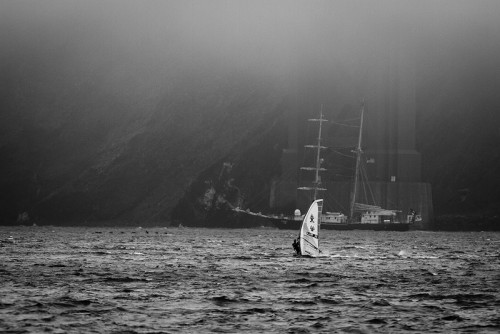
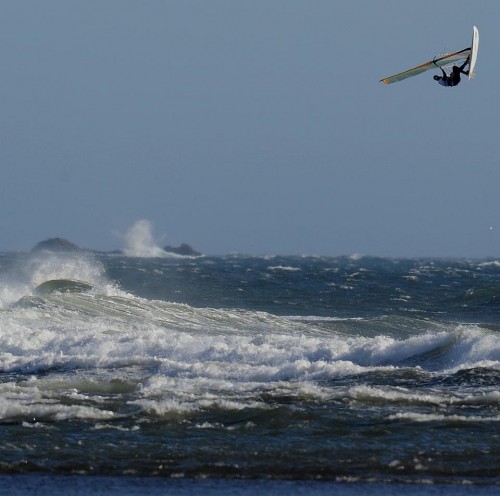
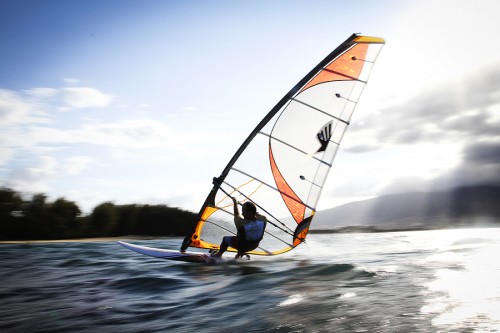
On the trading floor of the New York Mercantile Exchange, I was told “why” is for losers. The why of the price of gold does not actually matter, and if you focus on finding the why, you’ll miss the window of time to trade. And, some convincing philosophers go so far as to say that you can never ever know why A leads to B. “Why” is a ghost made for guessing. More important is to know the what, as in “What the hell appears to be happening?” Which is to say, you make more money when you don’t waste time trying to figure out the causes and effects of this complex world.
But this is windsurfing, not Wall Street. And in this morning moment, I’m inclined to investigate a kind of why: The “why” of Why we windsurf. Or rather, why I windsurf. The indoor world cup in Warsaw, surfprisingly helped me to better understand my vocational call to the whitecaps.
The Warsaw World Cup was my first indoor windsurfing event, and I was very excited. When I was a kid, I liked the indoor events because they make windsurfing look like other sports. Instead of lonely, windy beaches, windsurfers perform for stadiums full of cheering spectators and music. Indoor windsurfing seems to have the legitimacy of other sports like futbol: ticket sales, food vendors, and most importantly fans in seats (here I mean “fan” in the sense of enthusiast or fanatic, not to be confused with the wind ventilator fans needed for indoor windsurfing).
What is indoor windsurfing I hear you ask? Well, it’s a pool set up in a stadium with large wind-producing fans. Three disciplines compete: freestyle (which is tricks on flat water), racing (in which the winner is the first over the finish line after going around the buoys), and jumping (which is performing aerial tricks after flying off of a metal ramp). Indoor windsurfing events were more common in the 90’s, so the fans and ramp were in storage for roughly a decade before being shipped to Warsaw.
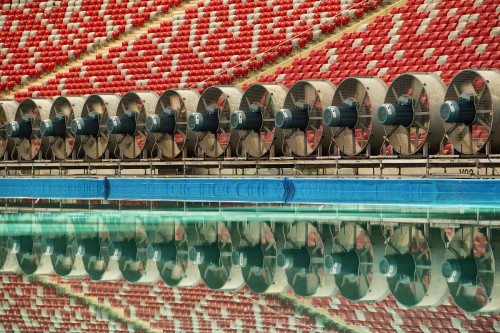
In 2014, I announced my return to competition and the PWA announced the Warsaw Indoor World Cup. I was more excited for the indoor than any other event. At the actual event, however, my excitement could not have disappeared more quickly.
That sounds negative, but I actually mean it positively. Even though this was a World Cup event in the sport to which I’ve dedicated my life, the Indoor had none of what I love about windsurfing. And by not having any of the “why” of “why I windsurf”, the Indoor event somehow made that “why” more obvious and important.
The world cup happened in Warsaw’s National Stadium, which is one of Europe’s more modern soccer/futbol venues. As exciting as competing in a large stadium was (which it was), I couldn’t ignore the resources (14,00 liters of fuel) needed to power the fans to create the wind. Apparently, the fans need a similar amount of energy as a small city. The idea of creating wind seems kinda silly, like the indoor ski hill in Dubai.
But silliness aside (has wastefulness or decadence actually stopped any event?), windsurfing indoors is nothing like windsurfing outdoors. Hitting the jump ramp was terrifying; in fact, the ramp was possibly scariest thing I’ve done windsurfing. The ramp is metal with a 10cm (4in) slot for the fin and rollers to help the board accelerate. It’s like going full speed at a metal wall with teeth. Hitting the lip at Jaws is not nearly so scary.
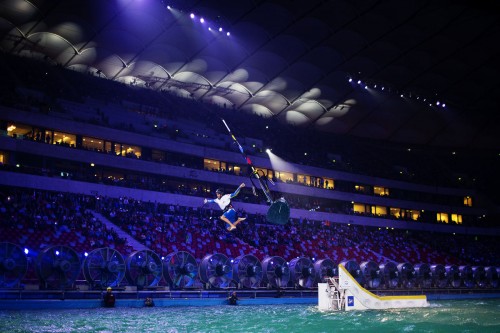
And what’s the point of the jump ramp? It’s nothing more than a stunt. Which is not to say that stunts are bad. Stunts are great fun to watch and to occasionally do. Google defines “stunt” as “an action displaying spectacular skill and daring.” Windsurfing can not be reduced to just “an action.” I’m not sure what the best words are to describe a windsurfing session. Continuous action? Man vs sea? Harnessing chaos? If you windsurf, you know what I mean. Sailing straight is not inaction. Tricks, jumps, jibes, waterstarts, and wave rides are all bursts of action on top of the base action that is sailing straight.
Jumping off a ramp indoors is none of this. Do you see the contrast? You can’t even launch very high off the ramp. Why risk injury by rocketing myself at this metal ramp for a stadium full of people that don’t know much about windsurfing but just want a good show?
When it came my turn to go off the ramp, I had already lost all care. I existed in a sort of blissful apathy. To sum up my event: I am happy that I can check off “indoor” from my list of To Do’s, and I finished 9th, which is worse than I could have done but also better than I could have done. On top of that, it was a very good show. Both the jumps and the racing were exciting to watch. The event saw close to 40k people in the stands, and I felt myself caught up in the excitement and music and announcers and lights. But none of that is windsurfing.
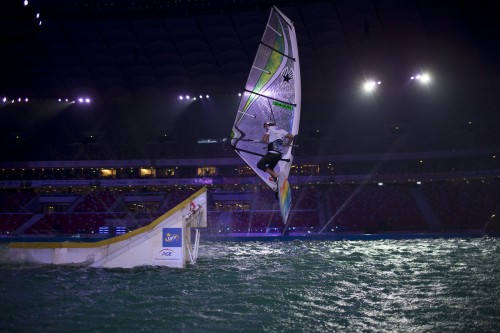
In the locker room and athlete area, I heard talk that the return of indoor is going to be the salvation of windsurfing. Before I did the indoor, I also thought that Indoor events could be a way to bring windsurfing to the mainstream. My dream was introducing indoor to the Olympics. No more waiting for wind, and the world would see windsurfing jumps to rival the snowboard half pipe. But now, my response is: no way. The Indoor is nothing at all like the magic that is windsurfing.
By magic I mean: man vs sea, man with sea, conquering fear against a greater power, amplified physical and mental awareness, exploration, the randomness of waves, etc, etc, etc.
Here is a paragraph pulled from an introduction to some of my poems that describes my difficulty in writing about windsurfing. I think it is appropriate here: “My experiences crossing patches of open ocean or riding 60ft waves were too powerful to convey–not unlike the difficulties described by others in writing about god. So much of being at sea is feeling scared and small, which is why some sailors devote their lives to the sea in the same way that some men turn to monasteries.”
The texture of the water—be it sea or lake—is a kind of organized chaos. Waves are water’s reaction to wind. Is it not perfect that windsurfing is the act of being one with both the wind and the waves? We ride a beautiful chaos—Nothing like the Indoor.
(But being the complicated hypocrite that I am, I might do another indoor event again. Though, I think the ramp needs a serious redesign to enable more modern jumps. In fact, I’ve come up with a new ramp design (any engineers interested in building it, drop me an email or comment).)
So if lights, cameras, and crowds are the opposite of a good windsurfing session, what is a good windsurfing session?
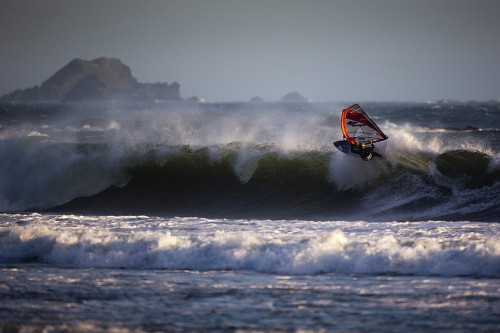
While I do like being watched on the water and having my photo taken (I’m very vain and never recovered from wanting my father to watch my windsurfing), the sessions that stand out most in my mind are the lonely ones. Or, better: I remember the alonely sessions (not at all lonely) without people but full of windsurfing and love and waves and maybe, just a little maybe, a friend or two. It is in these sessions that you fully realize that the windsurfer is a ship able to take you on a journey as adventurous as you can handle.
Many of us windsurfers (and our significant others) complain about the wind’s fickle nature—the idea of a switch to turn on the wind is very tempting. But, I think we actually secretly love this aspect of our sport. Yeah, windsurfing is not like tennis or futbol in terms of reliability, but that makes it better, not worse. Good days are rare, and that makes them special.
Earlier in this article I compared windsurfing to religion. While windsurfing is obviously not a religion, windsurfing becomes a “why” for the other parts of our lives. Windsurfing is the reason for owning a van or going on vacation to Cape Town or not planning anything for a weekend 2 weeks in advance because it might be windy then.
A common practice in windsurfing is to pray (yes, pray) to the wind god (or the deity of your predilection) that the wind aligns with the clock so that we can go on the water. This introduces the supernatural to our every day (and mostly secular and apathetic) lives. I’m not one for superstition or religiosity, but when it comes to the wind and waves, I am. And I think we all are, even if just a little.